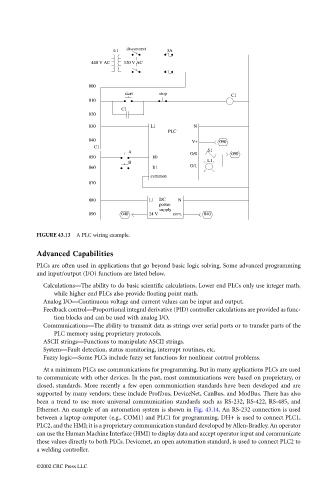Page 1153 - The Mechatronics Handbook
P. 1153
4:1 disconnect 3A
440 V AC 120 V AC
000
start stop
C1
010
C1
020
030 L1 N
PLC
040
V+ 090
C1
A O/0 S1 090
050 I/0
B L1
060 I/1 O/1
common
070
080 L1 DC N
power
supply
090 040 24 V com. 040
FIGURE 43.13 A PLC wiring example.
Advanced Capabilities
PLCs are often used in applications that go beyond basic logic solving. Some advanced programming
and input/output (I/O) functions are listed below.
Calculations—The ability to do basic scientific calculations. Lower end PLCs only use integer math,
while higher end PLCs also provide floating point math.
Analog I/O—Continuous voltage and current values can be input and output.
Feedback control—Proportional integral derivative (PID) controller calculations are provided as func-
tion blocks and can be used with analog I/O.
Communications—The ability to transmit data as strings over serial ports or to transfer parts of the
PLC memory using proprietary protocols.
ASCII strings—Functions to manipulate ASCII strings.
System—Fault detection, status monitoring, interrupt routines, etc.
Fuzzy logic—Some PLCs include fuzzy set functions for nonlinear control problems.
At a minimum PLCs use communications for programming. But in many applications PLCs are used
to communicate with other devices. In the past, most communications were based on proprietary, or
closed, standards. More recently a few open communication standards have been developed and are
supported by many vendors; these include Profibus, DeviceNet, CanBus, and ModBus. There has also
been a trend to use more universal communication standards such as RS-232, RS-422, RS-485, and
Ethernet. An example of an automation system is shown in Fig. 43.14. An RS-232 connection is used
between a laptop computer (e.g., COM1) and PLC1 for programming. DH+ is used to connect PLC1,
PLC2, and the HMI; it is a proprietary communication standard developed by Allen-Bradley. An operator
can use the Human Machine Interface (HMI) to display data and accept operator input and communicate
these values directly to both PLCs. Devicenet, an open automation standard, is used to connect PLC2 to
a welding controller.
©2002 CRC Press LLC

